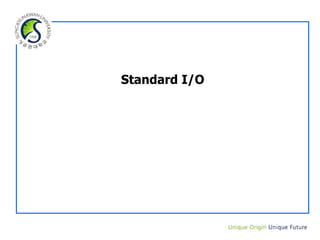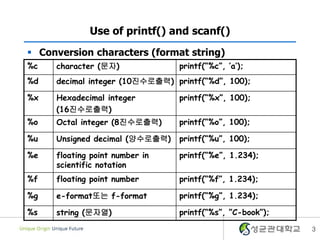2 3. standard io
- 1. Standard I/O
- 2. Use of printf() and scanf() ’é¦ printf()ļŖö Print FormatņØś ņĢĮņ¢┤ļĪ£, ĒÖöļ®┤ņŚÉ ļé┤ņÜ®ņØä ņČ£ļĀźĒĢĀ ļĢī ņé¼ ņÜ®ĒĢśļŖö ļ¬ģļĀ╣(ŪĻ©ņłś)ņØ┤ļŗż. printf(ŌĆ£format string..ŌĆØ, argument list); [Ex] #include <stdio.h> int main() { int n ; n = 25 * 10; printf(ŌĆ£%dŌĆØ, n); } [Ex] printf(ŌĆ£%c%c%cŌĆØ, ŌĆÖaŌĆÖ, ŌĆÖbŌĆÖ, ŌĆÖcŌĆÖ ); printf(ŌĆ£%sŌĆØ, ŌĆ£defŌĆØ ); /* 250 ņØ┤ ņČ£ļĀźļÉ£ļŗż. */ /* abc Ļ░Ć ņČ£ļĀźļÉ£ļŗż. */ /* def Ļ░Ć ņČ£ļĀźļÉ£ļŗż. */ 2
- 3. Use of printf() and scanf() ’é¦ Conversion characters (format string) %c character (ļ¼Ėņ×É) printf(ŌĆ£%cŌĆØ, ŌĆÖaŌĆÖ); %d decimal integer (10ņ¦äņłśļĪ£ņČ£ļĀź) printf(ŌĆ£%dŌĆØ, 100); %x Hexadecimal integer (16ņ¦äņłśļĪ£ņČ£ļĀź) printf(ŌĆ£%xŌĆØ, 100); %o Octal integer (8ņ¦äņłśļĪ£ņČ£ļĀź) printf(ŌĆ£%oŌĆØ, 100); %u Unsigned decimal (ņ¢æņłśļĪ£ņČ£ļĀź) printf(ŌĆ£%uŌĆØ, 100); %e floating point number in scientific notation printf(ŌĆ£%eŌĆØ, 1.234); %f floating point number printf(ŌĆ£%fŌĆØ, 1.234); %g e-formatļśÉļŖö f-format printf(ŌĆ£%gŌĆØ, 1.234); %s string (ļ¼Ėņ×ÉņŚ┤) printf(ŌĆ£%sŌĆØ, ŌĆØC-bookŌĆØ); 3
- 4. Use of printf() and scanf() ’é¦ The Use of printf() : integer %d printf(ŌĆ£ %mdŌĆØ, a ); printf(ŌĆ£ %-mdŌĆØ, a); /*m ņĀĢņłś.ņśżļźĖņ¬ĮņĀĢļĀ¼ */ /*m ņĀĢņłś. ņÖ╝ņ¬ĮņĀĢļĀ¼ */ [Ex] a = 12; printf(ŌĆ£%5d%-5d%dnŌĆØ ,a, a, a+11); 12^^^^^^1223 ŌĆō %5dļĪ£ ņČ£ļĀź : 12^^^ ( 5ņ×Éļ”¼ņŚÉ ņÖ╝ņ¬ĮņĀĢļĀ¼ļĪ£ ņČ£ļĀź, ļÆżņ¬Į Ļ│ĄĻ░äņØ┤ ļé©ņ£╝ļ®┤ Ļ│Ąļ░▒ņ£╝ļĪ£ ņ▒äņøĆ) ŌĆō %-5dļĪ£ ņČ£ļĀź : ^^^12 ( 5ņ×Éļ”¼ņŚÉ ņśżļźĖņ¬ĮņĀĢļĀ¼ļĪ£ ņČ£ļĀź, ņĢ×ņŚÉ Ļ│ĄĻ░äņØ┤ ļé©ņ£╝ļ®┤ Ļ│Ąļ░▒ņ£╝ļĪ£ ņ▒äņøĆ) ŌĆō %dļĪ£ ņČ£ļĀź : 23 (a +11ņØś Ļ░Æ ŌĆś23ŌĆÖņØä ĻĘĖļīĆļĪ£ ņČ£ļĀź) 4
- 5. Use of printf() and scanf() ’é¦ The Use of printf() : float %f printf(ŌĆ£ %m.pfŌĆØ, a ); printf(ŌĆ£ %-m.pfŌĆØ, a); /*m, p ņĀĢņłś.ņśżļźĖņ¬ĮņĀĢļĀ¼ */ /*m, p ņĀĢņłś. ņÖ╝ņ¬ĮņĀĢļĀ¼ */ [Ex] 83.1260^^83.126083.126000^^^83.13 a = 83.126; printf(ŌĆ£%8.4f%-8.4f%f%-7.2fnŌĆØ, a, a, a, a ); ŌĆō %8.4f : 83.1260^ (ņåīņłśņĀÉņØä ĒżĒĢ© ņ┤Ø 8ņ×Éļ”¼ņŚÉ ņł½ņ×Éļź╝ ņČ£ļĀźĒĢśļÉś ņåīņłśņĀÉ ņØ┤ĒĢś 4ņ×Éļ”¼Ļ╣ī ņ¦Ć Ēæ£ņŗ£. ) ŌĆō %-8.4f : ^83.1260 (%8.4fņÖĆ ļÅÖņØ╝ , ĻĘĖļ¤¼ļéś ņØīņłśļĪ£ ņØĖĒĢ┤ ņśżļźĖņ¬Įņ£╝ļĪ£ ņĀĢļĀ¼) ŌĆō %f : 83.126000 (ņ╣Ėņłś ņĀ£ĒĢ£ ņŚåņØ┤ ņåīņłśņĀÉ ņØ┤ĒĢś 6ņ×ÉļĪ£ ņČ£ļĀź) ŌĆō %-7.2f : ^^^83.13 (7ņ×Éļ”¼ ĒÖĢļ│┤ņŚÉ ņåīņłśņĀÉ ņØ┤ĒĢś 2ņ×Éļ”¼-ļ░śņś¼ļ”╝, ņśżļźĖņ¬Į ņĀĢļĀ¼) 5
- 6. Use of printf() and scanf() ’é¦ Use of scanf() ŌĆō scanf() - key boardļĪ£ļČĆĒä░ dataļź╝ ņ×ģļĀź ļ░øĻĖ░ ņ£äĒĢ┤ ņé¼ņÜ®ĒĢśļŖö ŪĻ©ņłśņØ┤ ļŗż. scanf(ŌĆ£format string..ŌĆØ, argument list); %c character (ļ¼Ėņ×É) scanf(ŌĆ£%cŌĆØ, &a); %d decimal integer (10ņ¦äņłś) scanf(ŌĆ£%dŌĆØ, &a); %f floating point number (float) scanf(ŌĆ£%fŌĆØ, &a); %lf floating point number (double) scanf(ŌĆ£%lfŌĆØ, &a); %Lf floating point number (long double) scanf(ŌĆ£%LfŌĆØ, &a); %s string (ļ¼Ėņ×ÉņŚ┤) scanf(ŌĆ£%sŌĆØ, &a); 6
- 7. Use of printf() and scanf() [Ex] #include <stdio.h> int main() { int n ; printf(ŌĆ£Enter number : ŌĆ£); scanf(ŌĆ£%dŌĆØ, &n); printf(ŌĆ£You entered : %dŌĆØ, n); return 0; } Enter number : 10 You entered : 10 7


![Use of printf() and scanf()
’é¦ printf()ļŖö Print FormatņØś ņĢĮņ¢┤ļĪ£, ĒÖöļ®┤ņŚÉ ļé┤ņÜ®ņØä ņČ£ļĀźĒĢĀ ļĢī ņé¼
ņÜ®ĒĢśļŖö ļ¬ģļĀ╣(ŪĻ©ņłś)ņØ┤ļŗż.
printf(ŌĆ£format string..ŌĆØ, argument list);
[Ex]
#include <stdio.h>
int main() {
int n ;
n = 25 * 10;
printf(ŌĆ£%dŌĆØ, n);
}
[Ex]
printf(ŌĆ£%c%c%cŌĆØ, ŌĆÖaŌĆÖ, ŌĆÖbŌĆÖ, ŌĆÖcŌĆÖ );
printf(ŌĆ£%sŌĆØ, ŌĆ£defŌĆØ );
/* 250 ņØ┤ ņČ£ļĀźļÉ£ļŗż. */
/* abc Ļ░Ć ņČ£ļĀźļÉ£ļŗż. */
/* def Ļ░Ć ņČ£ļĀźļÉ£ļŗż. */
2](https://image.slidesharecdn.com/2-3-140310043238-phpapp01/85/2-3-standard-io-2-320.jpg)

![Use of printf() and scanf()
’é¦ The Use of printf() : integer %d
printf(ŌĆ£ %mdŌĆØ, a );
printf(ŌĆ£ %-mdŌĆØ, a);
/*m ņĀĢņłś.ņśżļźĖņ¬ĮņĀĢļĀ¼ */
/*m ņĀĢņłś. ņÖ╝ņ¬ĮņĀĢļĀ¼ */
[Ex]
a = 12;
printf(ŌĆ£%5d%-5d%dnŌĆØ ,a, a, a+11);
12^^^^^^1223
ŌĆō %5dļĪ£ ņČ£ļĀź : 12^^^
( 5ņ×Éļ”¼ņŚÉ ņÖ╝ņ¬ĮņĀĢļĀ¼ļĪ£ ņČ£ļĀź, ļÆżņ¬Į Ļ│ĄĻ░äņØ┤ ļé©ņ£╝ļ®┤ Ļ│Ąļ░▒ņ£╝ļĪ£ ņ▒äņøĆ)
ŌĆō %-5dļĪ£ ņČ£ļĀź : ^^^12
( 5ņ×Éļ”¼ņŚÉ ņśżļźĖņ¬ĮņĀĢļĀ¼ļĪ£ ņČ£ļĀź, ņĢ×ņŚÉ Ļ│ĄĻ░äņØ┤ ļé©ņ£╝ļ®┤ Ļ│Ąļ░▒ņ£╝ļĪ£ ņ▒äņøĆ)
ŌĆō %dļĪ£ ņČ£ļĀź : 23
(a +11ņØś Ļ░Æ ŌĆś23ŌĆÖņØä ĻĘĖļīĆļĪ£ ņČ£ļĀź)
4](https://image.slidesharecdn.com/2-3-140310043238-phpapp01/85/2-3-standard-io-4-320.jpg)
![Use of printf() and scanf()
’é¦ The Use of printf() : float %f
printf(ŌĆ£ %m.pfŌĆØ, a );
printf(ŌĆ£ %-m.pfŌĆØ, a);
/*m, p ņĀĢņłś.ņśżļźĖņ¬ĮņĀĢļĀ¼ */
/*m, p ņĀĢņłś. ņÖ╝ņ¬ĮņĀĢļĀ¼ */
[Ex]
83.1260^^83.126083.126000^^^83.13
a = 83.126;
printf(ŌĆ£%8.4f%-8.4f%f%-7.2fnŌĆØ, a, a, a, a );
ŌĆō %8.4f : 83.1260^
(ņåīņłśņĀÉņØä ĒżĒĢ© ņ┤Ø 8ņ×Éļ”¼ņŚÉ ņł½ņ×Éļź╝ ņČ£ļĀźĒĢśļÉś ņåīņłśņĀÉ ņØ┤ĒĢś 4ņ×Éļ”¼Ļ╣ī
ņ¦Ć Ēæ£ņŗ£. )
ŌĆō %-8.4f : ^83.1260
(%8.4fņÖĆ ļÅÖņØ╝ , ĻĘĖļ¤¼ļéś ņØīņłśļĪ£ ņØĖĒĢ┤ ņśżļźĖņ¬Įņ£╝ļĪ£ ņĀĢļĀ¼)
ŌĆō %f
: 83.126000
(ņ╣Ėņłś ņĀ£ĒĢ£ ņŚåņØ┤ ņåīņłśņĀÉ ņØ┤ĒĢś 6ņ×ÉļĪ£ ņČ£ļĀź)
ŌĆō %-7.2f : ^^^83.13
(7ņ×Éļ”¼ ĒÖĢļ│┤ņŚÉ ņåīņłśņĀÉ ņØ┤ĒĢś 2ņ×Éļ”¼-ļ░śņś¼ļ”╝, ņśżļźĖņ¬Į ņĀĢļĀ¼)
5](https://image.slidesharecdn.com/2-3-140310043238-phpapp01/85/2-3-standard-io-5-320.jpg)

![Use of printf() and scanf()
[Ex]
#include <stdio.h>
int main() {
int n ;
printf(ŌĆ£Enter number : ŌĆ£);
scanf(ŌĆ£%dŌĆØ, &n);
printf(ŌĆ£You entered : %dŌĆØ, n);
return 0;
}
Enter number : 10
You entered : 10
7](https://image.slidesharecdn.com/2-3-140310043238-phpapp01/85/2-3-standard-io-7-320.jpg)